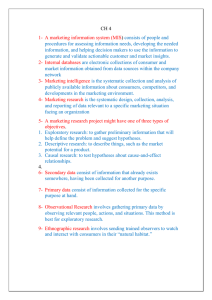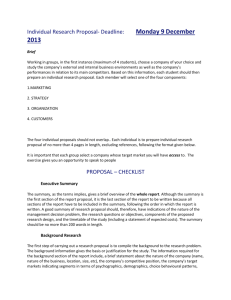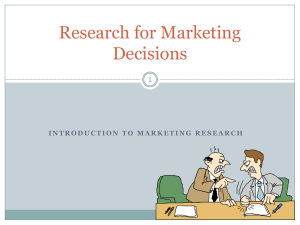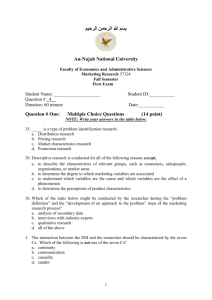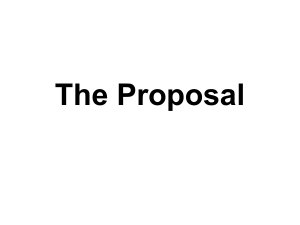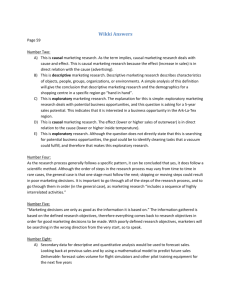Objective Chap. 3 Research Design Formulation Marketing Research Process
advertisement
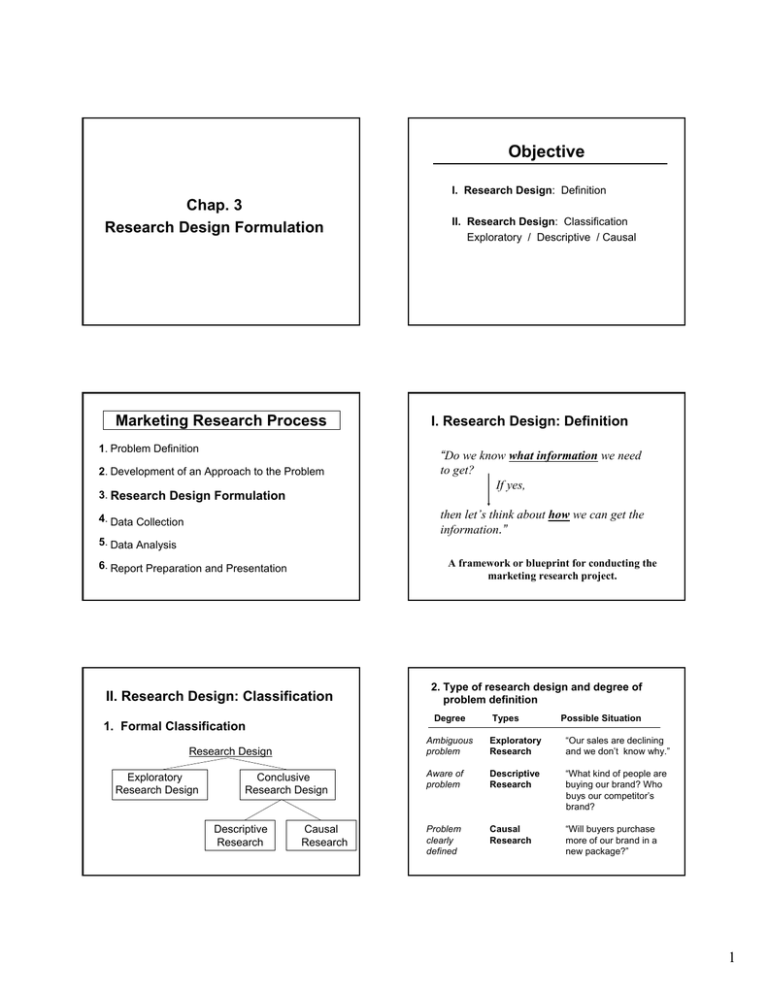
Objective Chap. 3 Research Design Formulation Marketing Research Process 1. Problem Definition 2. Development of an Approach to the Problem 3. Research Design Formulation I. Research Design: Definition II. Research Design: Classification Exploratory / Descriptive / Causal I. Research Design: Definition “Do we know what information we need to get? If yes, then let’s think about how we can get the information.” 4. Data Collection 5. Data Analysis A framework or blueprint for conducting the marketing research project. 6. Report Preparation and Presentation II. Research Design: Classification Degree 1. Formal Classification Research Design Exploratory Research Design Conclusive Research Design Descriptive Research 2. Type of research design and degree of problem definition Causal Research Types Possible Situation Ambiguous problem Exploratory Research “Our sales are declining and we don’t know why.” Aware of problem Descriptive Research “What kind of people are buying our brand? Who buys our competitor’s brand? Problem clearly defined Causal Research “Will buyers purchase more of our brand in a new package?” 1 - [1] Exploratory Research 2 - [2] Descriptive Research 2 • Objective: Discovery of insights/guidelines • Objective: To describe market characteristics • When: Usually at the initial stages of the marketing research process • When: After exploratory research’s been done or from the first stage of the research • Method: Secondary data / Expert survey / Pilot survey • Method: Secondary data / Panels / Survey • Sample and Question: Small sample & Open-ended questions • Sample: Large representative sample • Remarks: The results are not conclusive. Findings could be confirmed or falsified by any of conclusive research. - [2] Descriptive Research: 2 Cross - Sectional – Example • Remarks: The results are conclusive. Cross-Sectional & Longitudinal - [2] Descriptive Research: 2 Longitudinal – Example: cross-sectional data may not show change Types of cross - sectional research SFO Panel : 1,000 people If the marketing researcher asked those questions to 1,000 people in June, 1990 only once ⇒ Single cross-sectional research design If he asked the same questions to 1,000 people in June 1990, 1994, and 1998, three times, ⇒ Multiple cross-sectional research design - [2] Descriptive Research: 2 Longitudinal – Example Jun. A 2002 B C B 300 C 500 Total 1,000 Sep. 2002 ‘what ketchup brand did you purchase?’ A 200 Evaluation Criteria Sep. 2002 B 50 100 150 300 A 200 B 300 C 500 Total 1,000 - [2] Descriptive Research: Comparison 2 - Cross- S ectional vs Longitudinal Î Brand switching matrix A 100 50 50 200 Jun. 2002 ‘what ketchup brand did you purchase?’ C 50 150 300 500 200 300 500 1000 Cross-Sectional Design Detecting change Large amount of data collection Accuracy Representative Sampling Response bias Longitudinal Design + + + + + 2 - [3] Causal Research: Example 2 - Use of Music in Advertising - [3] Causal Research 2 • Objective: To determine cause-effect relationship • When: - Usually after exploratory research(or sometimes descriptive research)’s been done - When research problem is clearly defined • Method: Experiment • Remarks: - The results are conclusive. - Compared with descriptive research, it gives relatively clearer suggestion about marketing decision making. - [3] Causal Research: Example 2 - Use of Music in Advertising Results ROOM 1 50 Ad. 50 Ad. Comfortable Uncomfortable Music: Asking: “How likely are you to purchase this brand?” 3 I 4 I Neutral 5 I Unlikely 6 I Average: ROOM 1 ROOM 2 50 Ad. 2 I • Experiment: - 100 students in business school - An ad for a new product [a ball point pen] - [3] Causal Research: Example 2 - Use of Music in Advertising Split the students into two groups. 1 I Extremely • Hypothesis: The music in the Ad will affect consumers’ purchase intention. 7 I Extremely Likely ROOM 2 50 Ad. 6.5 3.4 Conclusion: - Music in ad affects whether consumers want to purchase the product. - We conclude that there must be a relationship between music in the ad and consumer’s purchase intention. - Can you think of a situation when music may not be a factor? - [4] Comparison 2 (1) Researcher’s Prior Knowledge few Exploratory Descriptive much Causal Descriptive clear Causal (2) Statement of Problem unclear Exploratory 3
